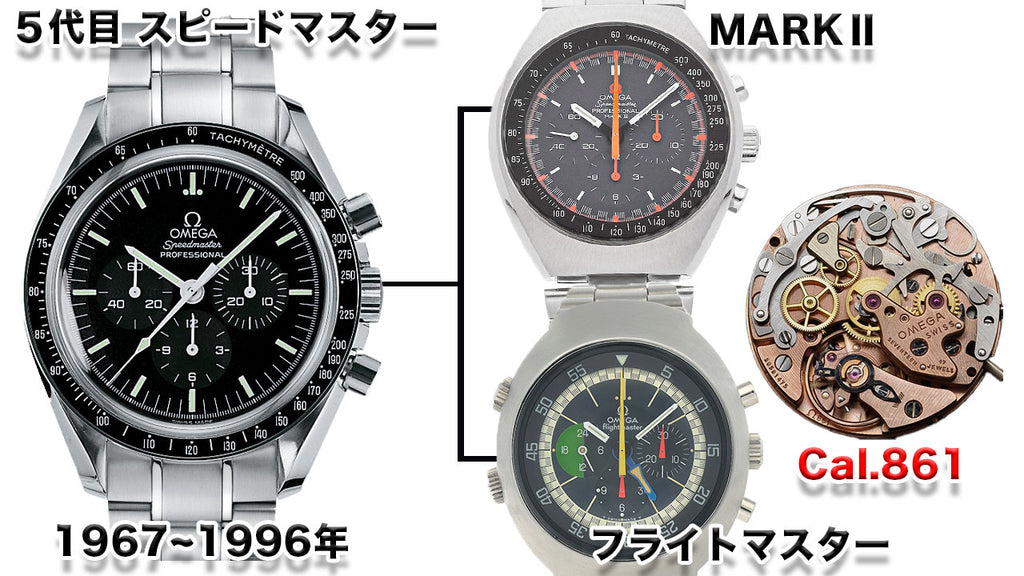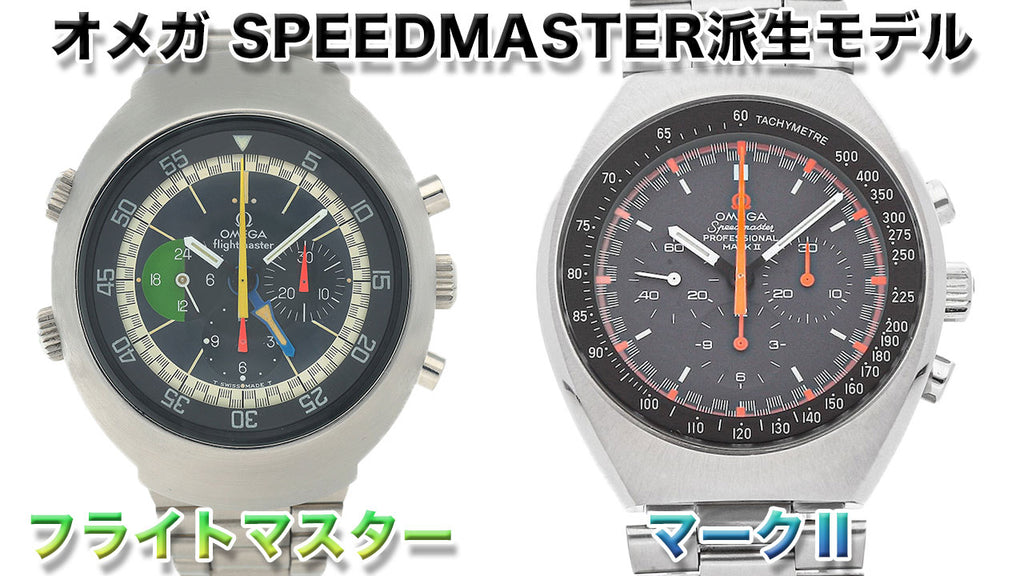The disappearance of the Omega Speedmaster derivative! Explaining the appeal of the automatic model
If you would like to watch a video about the Speedmaster derivative models, please click here ↓
Last time, we explained the evolution of the Speedmaster over the years.
This time, I will mainly be explaining the derivative models that were born during the evolution of the Speedmaster.
While most people may know about the current Speedmaster derivatives, I think most people don't know what the derivative models that disappeared before were like.
By watching this video until the end, you will understand why there are so many different Speedmaster models and the history of the movement's evolution, so please watch until the end.
A history of Speedmaster variants

As the first watch to walk on the moon, the Speedmaster made its mark on mankind at the same time it was launched in two models in 1969.
These are the derivative models called the Speedmaster "Mark II" and the "Flightmaster".

The Flightmaster uses a thick oval case that was popular in the 1970s, while the Mark II uses a regular case, although the surface looks oval.


From here, we will look at the historical background and explain why these models were created.
The year 1969 was the first year of the automatic chronograph, and automatic chronographs were born in three main groups.
The first was the Zenith-Movado alliance, which released the automatic chronograph "El Primero", the second was the Heuer-Breitling-Hamilton alliance, which released the "Caliber 11", and the third was Seiko, which released the automatic chronograph "Speed Timer", and these quickly led to a demand for "automatic chronographs" in the market.
The year 1969 brought about a turning point in the watch industry, but Omega was unable to produce a representative automatic watch model.
Although the Flightmaster looks like an automatic watch, the movement it is actually equipped with is Cal. 861, and of course the Mark II is the same.
As a result of Omega's inability to bring an automatic model to market, they resorted to the strategy of adding a watch that looked like it was automatic as a last resort, which resulted in the creation of this watch.
By the way, these two watches were produced for two years and did not sell very well at the time, so they are traded at fairly high prices due to the small numbers produced.
These two models were born in such a delicate position, but the Mark III was born as a combination of them.
Now let's take a look at the next-generation model, Mark III.
The birth of the Speedmaster's first automatic model, the Mark III

In 1971, two years after various companies began releasing automatic chronographs in 1969, the Speedmaster Mark III was born as the Speedmaster's first automatic model.
In Omega's press release, the Mark III is described as "Omega's first automatic chronograph housed in a pilot's case," and this pilot's case refers to the oval case of the Flightmaster, which was designed specially for pilots in 1968.
This type of case was popular in the 1970s, and due to its extreme thickness and unique shape, it is also known overseas as the volcano.
The movement used is the Cal.1040, which is an automatic winding movement based on the hand-wound Cal.861.
Intuitively, it feels like the design has evolved from the Mark II, with functions inherited from the Flightmaster.
The changes include the change from manual winding to automatic winding, and the addition of a date display at the 3 o'clock position, giving it a style more typical of the 1970s.
The Mark III was also very short-lived, with a production period of just two years, and the oval case was no longer used after the Mark III, but these features were carried over to later automatic models.
So, from here on, I will explain what Omega's first automatic movement was like.
Omega's first automatic Cal.1040
As explained in the previous video, Lemania, which belonged to the SSIH Group, was a manufacturer capable of creating robust, unbreakable movements.
If you don't know much about Lemania, please watch this video:
Cal. 1040 is a movement jointly developed by Omega and Lemania, and is a chronograph movement based on Cal. 1340, which had already been developed by Lemania.
This Lemania Cal. 1340 movement is based on the Cal. 861 and was developed by the genius designers Raoult-Henri Erard and Albert Piguet.
Therefore, some parts are shared with Cal. 861.
Due to the sudden rise in labor costs in the 1960s, many companies were forced to reduce costs, but these efforts paid off, and the SSIH Group was able to establish a system for mass-producing versatile movements.
The movement features a two-register movement with subdials at 6 and 9 on the dial and four central hands.
We will explain each layout.
The two central baton hands are the hour and minute hands.
The remaining two hands are the "chronograph second hand" and the "60-minute chronograph counter" (hands shaped like an airplane).
12-hour counter at 6 o'clock, small seconds at 9 o'clock, date window at 3 o'clock
There is also a movement that is almost the same, the Cal. 1041, which is a chronometer version of the Cal. 1040 .
To sum up what we have discussed so far about the case and movement, Omega probably did not want to make any major changes to the design of the fifth generation chronograph, which had been the leading model in chronographs from the late 1960s through the 1970s, when other companies began releasing automatic chronographs.
Therefore, I believe that the Mark II and Mark III were created as fifth-generation derivatives, and that the Mark III in particular was intended to popularize Omega's automatic models.
Mark IV, Automatic and Cal.1045

The successor to the Mark III, the Mark IV, was born in 1973.
The movement is still Cal. 1040, but the case is much thinner.
It feels like it has inherited the design of the Mark III, but with a case from the Mark II.
Since the movement is the same, the functions are the same as the Mark III.
The Mark IV also had a short production period, with production ceasing after just two years from 1973 to 1975.
Up until the Mark IV, the word “PROFESSIONAL” was inscribed on the dial, but this inscription was removed with the last model, the Mark IV.
It was also thought that the next model would be a V, but that has not happened, and it looks like the next model will in fact be the Speedmaster Automatic.
Now let's take a look at the Speedmaster Automatic.
The new Speedmaster Automatic that appeared in 1974 was equipped with the Caliber 1045, Omega's version of the Lemania Caliber 5100.
Now, let's take a closer look at the Lemania Cal. 5100 movement, which is said to be a masterpiece.
To put it simply, the Lemania Cal. 5100 is a movement made from simple materials such as pressed steel and plastic.
It was created to compete with the inexpensive quartz movements produced by Seiko at the time, and was designed to be inexpensive to assemble and maintain.
It is a complete evolution of the caliber that was installed in the Mark III and IV, and can be said to be a movement that has achieved cost reduction while improving performance.
It has the same functions as the previous caliber 1340, so it is characterized by having four hands.
The general perception of this movement is that it is a generic, cheap movement, and that is certainly true.
However, the actual movement is functional, precise, and robust, and if it is installed in a high-end brand, it would be understandable if it was called cheap, but if it is produced by a watch brand that is used in harsh environments, it can be said to be an excellent movement in terms of performance.
However, even though it was equipped with this movement, it could not compete with the image of a robust watch such as the Porsche Design Orfina, which was equipped with the same movement at the time and had a strong presence, so it still seemed to have a delicate position within Omega.

For more information on the Porsche Design Orfina watch, please watch this video:
The Speedmaster Automatic was produced for four years, from 1974 to 1978.
Later, in 1979, the Speedmaster Professional Quartz was released, but this watch was also soon discontinued, so we will not go into detail about it here.

Speedmaster Reduced & Date

The Speedmaster released a quartz line, but the quartz models hardly sold, so they evolved the automatic watch and created a new model.
The first one was the Speedmaster Reduced, released in 1988.
The word "reduced" means "reduced" in English, and as the name suggests, it is a cheaper version of the Speedmaster.
Speaking of other companies, Rolex and Tudor have also done this successfully: by changing the movement to a cheaper one, they have created a model that looks like the original Speedmaster but is available at a lower price.
Until now, there had been a lot of trial and error in trying to popularize the automatic Speedmaster, but these attempts had failed. With the birth of this model, however, these efforts have paid off.
The movement was ETA's Cal. 2890, which was found in inexpensive chronographs, with a Dubois-Dépraz chronograph module.
Previous models had a short lifespan of about two years, but this model became a long-selling model that was manufactured for approximately 25 years, until 2012.
The Speedmaster Date was born in 1990, two years after the release of the Reduced.

It is based on ETA's signature movement, Cal. 7750, and is equipped with Cal. 1164.
(The movement in the image is the Cal.3330, which is a coaxial version of that.)
Like the Reduced, this was launched as an inexpensive model and became a huge hit because it was practical for the price.
It was originally equipped with Cal. 1155, which was changed to Cal. 1152 and then evolved into Cal. 1164, the chronometer version of that.
The Cal. 3330 is a further co-axial version of this movement, and is used in the current Racing model.
summary
From the late 1970s to the early 1990s, the Speedmaster was unable to compete with quartz and had no choice but to use cheap, common automatic movements, but it managed to get through by increasing the number of models.
The automatic Speedmaster had struggled up to this point, but as was the case with other Swiss watch brands from the late 1990s, the brands that survived this period were able to make progress again.
Of course, Omega was no different; at the time, the market had begun to position mechanical watches as luxury items that valued the craftsmanship of artisans, rather than as outdated goods.
This Speedmaster derivative model had a difficult time from the late 1960s to the late 1980s, but it was this trial and error that allowed it to be passed down to the current model and lead to the automatic movement that Omega has created on its own.




